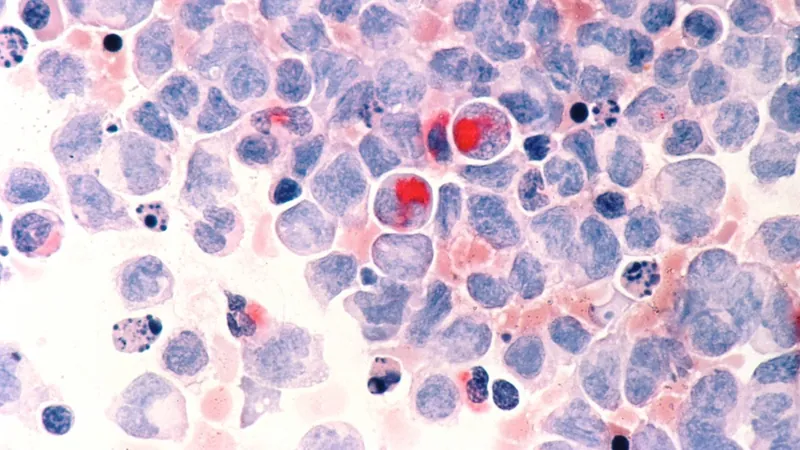
Groundbreaking Discovery Unveils Potential New Treatment Target for Acute Myeloid Leukemia
2024-11-12
Author: Wei
Groundbreaking Discovery Unveils Potential New Treatment Target for Acute Myeloid Leukemia
In a major breakthrough, researchers have identified a significant vulnerability in acute myeloid leukemia (AML), a particularly aggressive type of blood cancer. This newfound knowledge could lead to innovative treatment strategies aimed at hindering the disease's progression.
The study, spearheaded by scientists from The Institute of Cancer Research in London, reveals that by targeting a specific protein complex, known as the nucleosome-remodeling factor (NURF), researchers could develop new therapies to combat AML. In particular, the focus is on inhibiting a protein called BPTF, which is integral to the malignant growth of leukemia cells.
A Challenging Battle Against AML
Acute myeloid leukemia is notorious for its complexity and rapid progression, making it exceedingly difficult to treat. Current therapies often involve chemotherapy and bone marrow transplants, which, while sometimes effective, carry significant side effects and the potential for resistance. This research deepens our understanding of NURF's role in AML, highlighting a previously undiscovered alternative NURF complex that could serve as a useful target for therapies.
Experiments conducted in cell cultures demonstrated that disrupting BPTF and its associated NURF complex substantially impairs the cancer's ability to thrive. By elucidating BPTF's critical role in the survival of leukemia, the research team aspires to unveil safer treatment alternatives for patients struggling with this disease.
New Mechanisms Revealed
The study provides remarkable insights into the mechanistic functioning of NURF, showing its correlation with the 3D chromatin architecture within the cell. Intriguingly, it appears that the deregulation of NURF influences the spatial organization surrounding the MYC gene—a well-known cancer promoter. This discovery implies that the underlying mechanisms identified might extend beyond leukemia to other cancer types as well.
For the first time, the research showcases the establishment of an alternative NURF complex that incorporates the SMARCA5 gene as its catalytic subunit, challenging the previously held notion that SMARCA1 was the sole catalytic driver of NURF. The implications of this finding are vast, opening doors for further investigations into the functionality of this newly characterized NURF complex.
Paving New Pathways for Treatment
Dr. Alex Radzisheuskaya, leader of the Chromatin Biology Group at the ICR, expressed hope that this research could illuminate new therapeutic avenues for AML. "Instead of relying on traditional methods, this approach targets the fundamental organization of the cancer genome, potentially stunting its growth while being gentler on healthy cells," he remarked.
Co-author Dr. Isabel Peña Rømer added, "Our findings suggest specific regions within BPTF may not be as critical for leukemia survival as previously thought. This knowledge could inform more targeted therapies, improving outcomes while reducing adverse effects for patients."
Revolutionizing Cancer Research
Professor Kristian Helin, Chief Executive Officer of the ICR, accentuated the necessity of understanding the biological underpinnings of cancer for translating discoveries into actionable treatments. "Our work not only progresses our knowledge of AML but also enhances our broader endeavors to develop novel therapies that improve patient life quality, tackling this aggressive disease head-on."
As researchers continue to unravel the complexities of leukemia and its mechanisms, this discovery heralds a new chapter in targeted cancer therapies—one that might finally offer hope to the many patients affected by this daunting illness. Stay tuned as these innovative findings could change the landscape of cancer treatment forever!


 Brasil (PT)
Brasil (PT)
 Canada (EN)
Canada (EN)
 Chile (ES)
Chile (ES)
 España (ES)
España (ES)
 France (FR)
France (FR)
 Hong Kong (EN)
Hong Kong (EN)
 Italia (IT)
Italia (IT)
 日本 (JA)
日本 (JA)
 Magyarország (HU)
Magyarország (HU)
 Norge (NO)
Norge (NO)
 Polska (PL)
Polska (PL)
 Schweiz (DE)
Schweiz (DE)
 Singapore (EN)
Singapore (EN)
 Sverige (SV)
Sverige (SV)
 Suomi (FI)
Suomi (FI)
 Türkiye (TR)
Türkiye (TR)